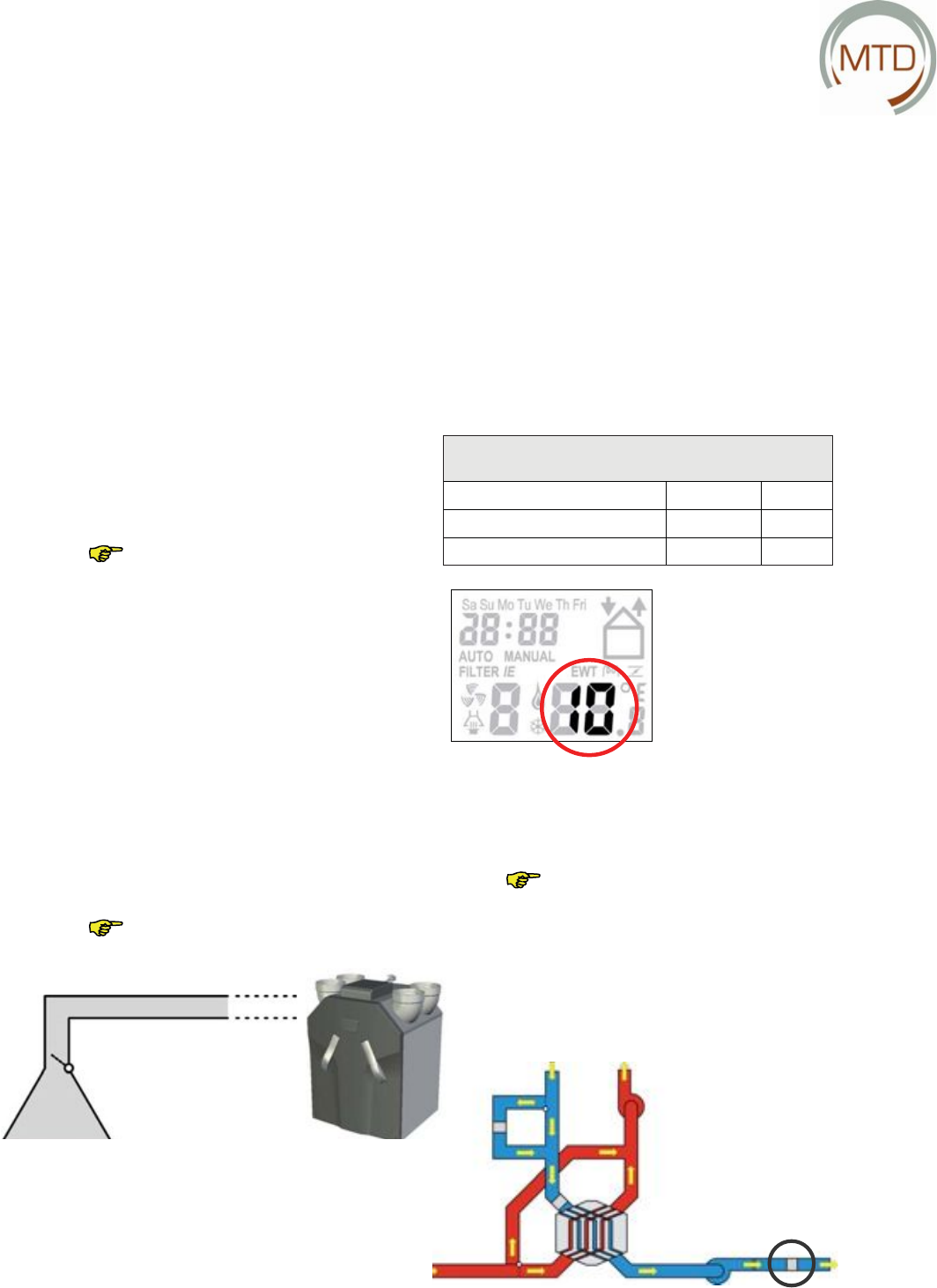
3
Menu P29:
Setting the rate of increase
v Rate of increase
Minimum 1%
v Rate of increase
Standard 10%
v Rate of increase
Maximum 99%
20 Function of the System
side air no longer has to be temporarily reduced (or
even interrupted for a short time) in order to pre-
vent condensation freezing in the heat exchanger.
Instead the preheater is temporarily switched on.
In addition, this option offers greater comfort as
the supply air is preheated to more or less room
temperature.
The preheater is switched on and off automati-
cally. As soon as the temperature of the outside
air is below 0
o
C for a certain period, the air duct
of the preheater is opened and the preheater is
switched on to heat the intaken outside air to at
least 1
o
C. Here a temperature sensor in the sup-
ply air duct of the MTD-ERV 350 measures the
temperature. This preheating control ensures bal-
anced ventilation up to a maximum of 150 m³/h at
-15
o
C. The user cannot infl uence the automatic
preheater control. The installer has to modify the
preheating control, for example during installa-
tion of the MTD-ERV 350, in menu P52 via the CC
Ease operating unit (for further information, see
section 4.4).
The preheater and the corresponding
temperature sensor must be connected
to the PCB panel behind the front panel
of the MTD-ERV 350 by the installer. In
the event of retrofi tting, installation in-
structions are supplied with the installa-
tion kit.
3.4.2. Ventilation via Extractor Hood*
An extractor hood can be connected to the MTD-
ERV 350.
This allows moisture (steam) and food odours
to be discharged as quickly as possible via the
ventilation system. For this, the extractor hood
must be connected to the PCB panel (extended
version) of the MTD-ERV 350. The extractor hood
can then be operated via the CC Ease operating
unit of the MTD-ERV 350.
Switching the extractor hood on and off,
see section 2.3.4.
As soon as the extractor hood is switched on
using the CC Ease operating unit, the valve of
the extractor hood opens and the MTD-ERV 350
switches to the 'Extractor hood' function. Ventila-
tion positions 1, 2 or 3 can be set. These ventila-
tion positions for the extractor hood correspond
to the 'normal' ventilation positions. Please note,
however, that these ventilation positions for the
extractor hood are always slightly higher (by x%)
than the 'normal' ventilation positions. The user
can set this x% value himself in menu P29 on the
CC Ease operating unit (see also section 2.3.7).
The following increase values can be selected:
In addition to this ventilation via the extractor
hood, a temperature sensor is also installed in
the extractor hood. This temperature sensor
measures the temperature of the air discharged
via the extractor hood. Should this temperature
become too high, i.e. more than 60
o
C, the valve
in the extractor hood will close to protect the
MTD-ERV 350 and in particular the heat/moisture
exchanger.
3.4.3 Post-heater* in Duct System
As an option, the ventilation system can also be
equipped with a post-heater.
The post-heater is a heater element that is in-
stalled in the duct system of the ventilation sys-
tem, in other words downstream of the MTD-ERV
350. The post-heater
ensures that after the
outside air has fi rst
been heated in the
heat/moisture ex-
changer of the MTD-
ERV 350, the sup-
ply air is additionally
heated before it en-
ters the living rooms.
The advantage of the
post-heater is that the supply air can be directly
admitted to the living rooms at the comfort tem-
perature set for the dwelling. That means addi-
tional comfort.
The post-heater is not supplied as stand-
ard with the MTD-ERV 350. It is actually
part of the duct system of the ventilation
system and does not belong to the scope
of supply of the MTD-ERV 350.
The post-heater is switched on and off automati-
cally. As soon as the temperature of the supply
air drops below the set comfort temperature, the
post-heater is switched on to heat up the supply air
to the comfort temperature. A temperature sensor
in the duct system measures the temperature of
the supply air immediately behind the post-heat-
er. The user cannot infl uence the automatic post-
heater control system. The post-heater reacts to
